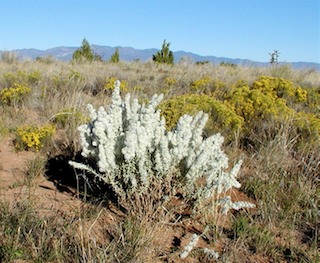
Every fall the open areas of Deer Canyon Preserve are decorated with low-growing shrubs topped with erect stems that resemble long fingers of silvery cotton candy. Known as winterfat because of its value as winter browse, this playful plant also goes by the common names white sage, winter sage, feather sage, sweet sage, and lambstail. Its scientific name is much less fanciful: Krascheninnikovia lanata. The genus honors Stephan Petrovich Krascheninnikov, a Russian botanist who accompanied the Danish explorer Bering on the Great Northern Expedition to Siberia from 1733 to 1743. The species epithet is particularly descriptive, meaning wooly, from the Latin word for wool, lana.
Winterfat is a perennial shrub that can be found in deserts, arid grasslands, woodland edges at almost all but the highest elevations throughout western North America. With both a long taproot and a network of fibrous roots near the surface it is a highly successful plant and can be unusually long-lived; one plant in Idaho was documented at 136 years old. A number of hairy stems arise from a central woody stem, but the plant rarely exceeds two feet in height. The leaves are up to 2” long and narrow with rolled edges. A dense covering of hairs gives the leaves a light gray color and they tend to remain on the plant throughout the winter. A new set of leaves will replace them in the spring.


As a member of the Chenopodiaceae, the goosefoot family, winterfat typically has separate male and female plants (like four-winged saltbush, another member of the Chenopodiaceae that was featured last November). Sometimes, however, the plants are monoecious with the male flowers positioned at the end of the stems and the female flowers below them on the same stem. Both male and female flowers are highly reduced in size, with no petals present. The left photo above shows clusters of male flowers that release pollen to the wind in mid summer at the ends of the longer branches. Other plants, like the one in the right photo above, bear clusters of female flowers that receive the pollen and develop small fruits each with one seed. The seed coats are covered with white silky hairs about 1/2” long, hence the wooly appearance. Seeds may be easily collected from the “cottony fingers” of female plants (photo below), but the seeds only remain viable for one or two years.

With a protein content above 10%, winterfat is a very good winter food source for cattle and a variety of wildlife species including antelope, deer, elk, and bighorn sheep. Its high seed germination rate and relatively fast growth rate make winterfat a good choice for erosion control projects and for efforts to reclaim areas of disturbed soil. Hopi Indians used powdered winterfat roots to dress burns and a decoction of its leaves to treat fevers. Navajos would apply chewed winterfat leaves to poison ivy and also used the plant to treat sores, boils, and smallpox. There’s no questioning the utility of this common shrub, and its value as a native landscape plant, but I must confess I like to have it around simply because it makes me smile.
Downloadable essay here.
© Jerry Melaragno 2009